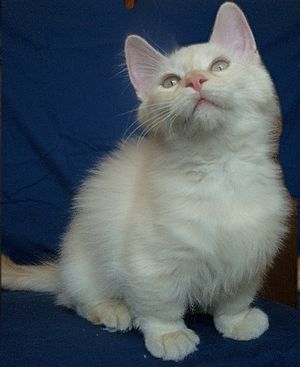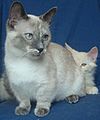Munchkin cat facts for kids
Quick facts for kids Munchkin |
|
|---|---|

An adolescent munchkin kitten.
|
|
| Origin | United States |
| Breed standards | |
| TICA | standard |
| AACE | standard |
| Domestic cat (Felis catus) | |
A Munchkin cat is a type of cat breed that is a medium sized cat weighing 4 to 9 lbs. They are known for their very short legs. This unique look is caused by a natural change in their genes. They are considered one of the first types of "dwarf cats."
Contents
History
The story of the Munchkin cat we know today really began in 1983 in Louisiana, USA. A music teacher named Sandra Hochenedel found two pregnant cats hiding under a truck. She kept one, named Blackberry, and was surprised when some of Blackberry's kittens were born with short legs!
Sandra gave one of Blackberry's short-legged male kittens, named Toulouse, to her friend Kay LaFrance. It's from Blackberry and Toulouse that the Munchkin breed we see now is descended.
Becoming an official breed
The Munchkin cat was first shown to the public on television in 1991 at a cat show held by The International Cat Association (TICA). People were curious about them!
It took a few years for the Munchkin to be considered an official breed. Some people were worried that having such short legs might cause health problems for the cats later on.
After being part of a special program for new breeds, the Munchkin was officially accepted by TICA in September 1994. They achieved full championship status, meaning they could compete in shows, in May 2003.
Not all cat groups agreed. Many other cat associations around the world decided not to recognize the Munchkin breed. They felt that breeding cats with this specific genetic difference might not be the best for the cats' long-term health and well-being. Groups like the Governing Council of the Cat Fancy (GCCF) in the UK and the Cat Fanciers' Association (CFA) in the US are among those that do not recognize the breed.
What do Munchkin cats look like?
Munchkin cats look a lot like regular domestic cats, just with shorter legs!
- Size: They are usually small to medium-sized cats. Male Munchkins are typically a bit heavier than females. Males might weigh between about 6 to 9 pounds (around 2.7 to 4.1 kilograms), while females are usually between 4 to 8 pounds (around 1.8 to 3.6 kilograms).
- Body: They have a moderate body shape. Sometimes, their back legs are a little longer than their front legs, making their body rise slightly from their shoulders to their back end.
- Legs: The most noticeable thing is their short legs! While their legs are short, they should be straight, though a slight curve might be seen. Legs that are too bowed or turned inward are not typical for the breed standard in shows.
- Coat: Munchkins come in all sorts of colors and patterns, just like other cats! They can have short, plush fur or longer, silky fur. The long-haired Munchkins are sometimes shown in a separate category.
Health and well-being
As mentioned earlier, the unique short legs of the Munchkin cat are caused by a genetic difference. Because of this genetic trait, there have been discussions and concerns about the potential for certain health issues in Munchkin cats. Some studies suggest they might have a higher chance of developing conditions that affect their spine or chest shape, or issues related to their joints as they get older.
While many Munchkins are active, some sources suggest their ability to jump very high might be limited compared to cats with longer legs.
Due to these health concerns, some countries and regions have decided to make breeding Munchkin cats against the law. For example, the Netherlands and certain parts of Australia have rules against breeding animals with genetic conditions that could cause health problems.
Because the Munchkin's short legs are a unique trait, some people have bred Munchkins with other cat breeds to create new types of cats. These are sometimes called "derived breeds" or "experimental crossbreeds." Many of these are not widely recognized by major cat associations.
Here are a few examples:
- Bambino: A mix of a Munchkin and a Sphynx (a hairless cat), resulting in a mostly hairless cat with short legs.
- Dwelf: A mix of a Munchkin, Sphynx, and American Curl (a cat with curled ears), having short legs, no hair, and curled ears.
- Genetta: A mix of Munchkin and Bengal (a spotted cat), aiming for a spotted cat with short legs.
- Kinkalow: A mix of Munchkin and American Curl, resulting in a cat with short legs and curled ears.
- Lambkin: A mix of Munchkin and Selkirk Rex (a cat with curly fur), creating a cat with short legs and curly fur.
- Minskin: Developed from Munchkin, Burmese, Sphynx, and Devon Rex cats, resulting in a cat with short legs and very little or no hair.
- Minuet (or Napoleon): A mix of Munchkin and Persian (or similar breeds), resulting in a cat with short legs and the flatter face shape of the Persian. This breed is recognized by TICA.
- Skookum: A mix of Munchkin and LaPerm (a cat with curly fur), resulting in a cat with short legs and curly fur.
These crossbreeds show how breeders experiment with different traits to create new looks, but it's always important to consider the health and well-being of the cats first.
Interesting facts about the Munchkin cat
- To keep the breed healthy and varied, Munchkins are often bred with regular domestic cats that don't belong to a specific breed. This helps maintain a wide range of looks and characteristics.
- In 2014, a Munchkin cat named Lilieput from California was recognized by Guinness World Records as the shortest living cat in the world, standing just 5.25 inches (about 133 millimeters) tall!
- The gene that causes the short legs in Munchkin cats is called an autosomal dominant mutation. This means that if a cat gets just one copy of this gene from either parent, they will have short legs.
- If a Munchkin cat (who has one copy of the short-leg gene) has kittens with a regular cat (who has no copies of the short-leg gene), about half of the kittens are likely to have short legs, and about half are likely to have normal-length legs.
- Cats that inherit two copies of the short-leg gene (one from each parent if both parents were Munchkins) usually do not survive. This is why responsible breeding practices are important to ensure the health and well-being of the kittens.
Images for kids
See also
 In Spanish: Munchkin (gato) para niños Selective breeding] Scottish Fold] Dachshund] Welsh Corgi]
In Spanish: Munchkin (gato) para niños Selective breeding] Scottish Fold] Dachshund] Welsh Corgi]


